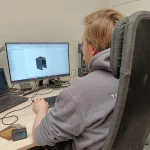Reaction Injection Molding
In recent years, significant changes have been observed in the realm of production and delivery. Alongside the price increases of raw materials, transportation costs have also risen in the past 3 years. Additionally, the lead time for parts has deteriorated due to a global shortage of raw materials. These developments have prompted many companies to seek alternatives. As a result, producing products at a local level is becoming increasingly popular.
An additional advantage of local production is that the lines between producer, supplier, and consumer become shorter, which often improves communication between the parties and, consequently, the quality of products. In addition to the possibility of starting a serial production with 3D printing, we are always looking for other alternatives to scale up production. We believe that technology provides an answer to offer an alternative to China and other manufacturing countries, making the choice to produce locally even easier for companies. In my opinion, reshoring is a crucial pillar if we want to resume production responsibly.
One of those alternatives is Reaction Injection Molding, or RIM. In 2020, we began exploring, researching, testing, and optimizing, and since early April 2022, we have been offering this technique to our customers. Since then, we have delivered several successful projects.
Reaction Injection Molding
Reaction Injection Molding is a manufacturing technique where products are made by injecting a liquid into molds. The molds ensure that the liquid takes the correct shape before it hardens. The end result is a product precisely in the shape of a mold that can be produced in a fraction of the time compared to, for example, 3D printing. The lead time for a mold can be as short as a few seconds in some cases.
3D-printed molds
Molds are typically manufactured using conventional production technologies from a lightweight metal such as aluminum. This forces designers to adapt their concepts to the limitations imposed by the production process. With a technology like milling, the geometric freedom of the design is very limited; complex shapes are hardly feasible. Time for innovation! We've been testing, testing, and testing, and now we're using our own 3D-printed molds! This not only offers the advantage of geometric freedom, but also drastically reduces mold costs, makes mold designs easily adjustable, and instead of a production time of weeks to months for milled molds, our molds are produced within hours to days. This results in a short lead time.
Reaction Injection Molding is commonly used for products that need to be produced in large quantities.
Due to the fast production and low cost of materials, some products can be made for very low prices, often just a few eurocents.
Reaction Injection Molding was developed in the early 1960s and became known during the International Plastic Fair in Dusseldorp. Here, RIM was used to make a complete car out of plastic. After this, RIM was discovered mainly in America and used to make car parts such as bumpers, spoilers and interior parts.
RIM slowly disappeared from the scene in the following years. Especially the demand for high production numbers at an extremely low price drove out technology. Injection molding machines took its place. But by using 3D printed molds, the RIM machine can once again compete with the injection molding machines!

